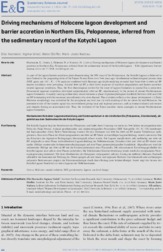Driving mechanisms of Holocene lagoon development and barrier accretion in Northern Elis, Peloponnese, inferred from the sedimentary record of the Kotychi Lagoon
Haenssler, Elke
Unkel, Ingmar
Dörfler, Walter
Nadeau, Marie-Josée
Haenssler, Elke; Unkel, Ingmar; Dörfler, Walter; Nadeau, Marie-Josée, 2014: Driving mechanisms of Holocene lagoon development and barrier accretion in Northern Elis, Peloponnese, inferred from the sedimentary record of the Kotychi Lagoon. In: E&G – Quaternary Science Journal; Vol.63, No.1, p.60-77, DOI: 10.3285/eg.63.1.04.
 |
Dokument öffnen: |
As part of the lagoon barrier accretions plain characterizing the NW coast of the Peloponnese, the Kotychi Lagoon is believed to have formed in the prograding delta of the Palaeo-Peneus River over 7000 years ago. Geochemical/sedimentological proxies-data (XRF, grain size, OC-, IC-, C/N-analysis) combined with Bayesian age-depth-modeling revealed that from 8500 to 8000 cal BP marine conditions were prevailing. Around 8000 cal BP, a short-lived sequence of coastline progradation and barrier accretion created lagoonal conditions. Thus, the first chronological control for the onset of lagoon formation in coastal Elis is presented. Pronounced lagoonal conditions developed approximately 6300 cal BP, simultaneously to the period of circum-Mediterranean lagoon formation. A rapidly varying sedimentary record indicates a phase of geomorphological instability between 5200 and 3500 cal BP terminating with the erosional unconformity of a river channel. This evolution reflects a two-phase development: (1) Early Holocene morphology was controlled by the postglacial sea level rise; (2) with receding of the ice sheets by mid-Holocene, the preeminent role of the eustatic signal was overwhelmed giving local and regional processes, such as human-induced soil erosion and climatic forcing an accentuated role. Thus, the evolution of the Elean coastline shows analogies to circum-Mediterranean lagoon formation.

